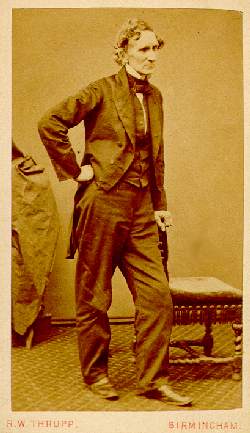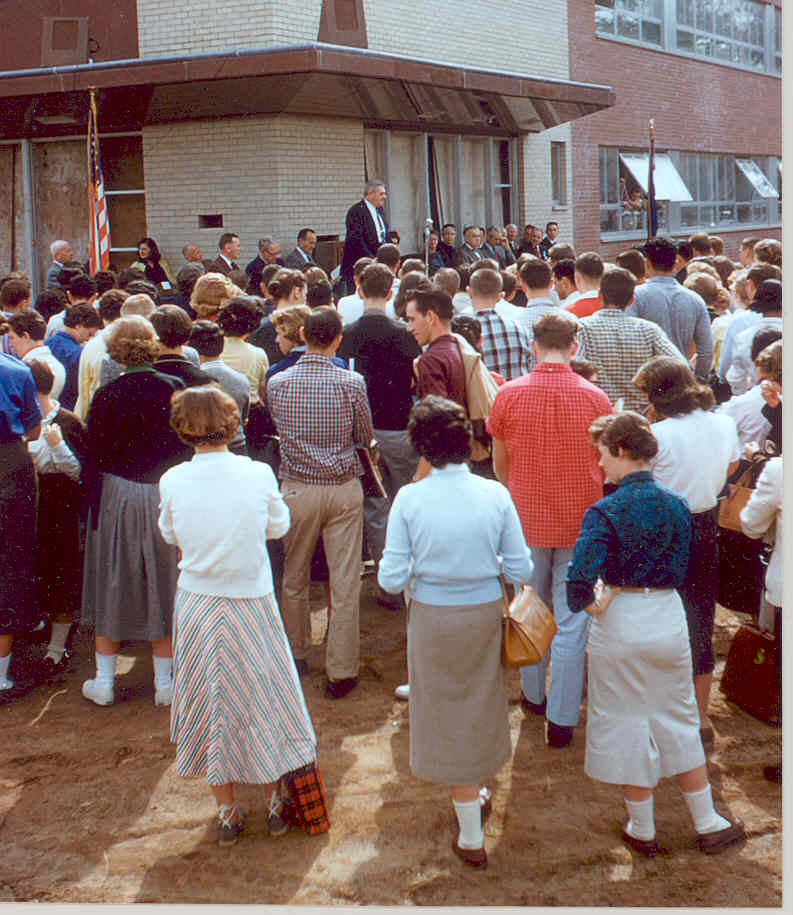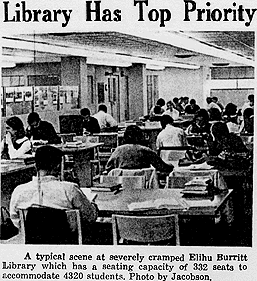
Tim Mitchell, Construction supervisor for Hayes Construction Co.
"Standard VII, The Library:Dr. Welte's annual report for 1952-1953, under the heading New Building Needed lists $1,512,000 for a new college library. In 1955, the General Assembly finally authorized $1,440,000 for a major addition to the campus power plant and a new library building.
The library is the weakest element in the educational picture at the Teachers College of Connecticut. The collection of books and periodicals, while seriously lacking only with respect to textbooks and curriculum materials used in the public schools, nevertheless, calls for fundamental strengthening in most areas. There are, moreover, far too many relatively useless books and duplicates, and authority to weed them out should be obtained. Efforts to achieve a wholly suitable library building should be continued and, if possible stepped up. In the meantime ways and means should be found to expand the space now available for the library, this being wholly inadequate. Moreover, vigorous attention should be given to improving the physical appearance, comfort, convenience, lighting, and ventilation of whatever space must be temporarily employed. These matters should not be neglected just because a new building may be hoped for in a few years."

| There is an interesting story on how the college was finally able to get its first separate library building. State Senator Paul Amenta fought for funding for the new facility. He was blocked by another powerful politician, E. O. Smith, who wanted a high school for Mansfield. They compromised and the city received its secondary school and Central its new library. Construction of the new building began in the spring of 1957. |
| Footings and piers for library-classroom building,
April, 1957.
Tim Mitchell, Construction supervisor for Hayes Construction Co. |
In his annual report for 1957-1958, Dr. Welte reported that the new library would have a capacity for 150,000 volumes and seating for 400 students. The library would occupy the first floor and one third of the second. The remainder of the second floor was home to the Social Science department. The third floor would be shared by Social Science and English departments. The ground floor provided space for a branch of the New Britain Public library, a speech therapy center, a closed circuit TV studio, a classroom and a conference room with kitchen facilities.
The naming of the new building came from a suggestion by Robert C. Vance, editor and publisher of the New Britain Herald. He recommended that the library be named for Elihu Burritt, a New Britain native. Burritt was known as the learned blacksmith and advocate of universal peace.

| 
|

| Seated directly behind President Welte is Library Director Robert Massman. |

| Another shot of Dedication Day speeches. |

| President Herbert Welte, left, and Sherrod E. Skinner, laying the cornerstone. |

| On May 17, 1959 the new building was dedicated. The featured speaker was Sherrod E. Skinner, a vice-president of General Motors and a great grand nephew of Elihu Burritt. |
| Dedication Day Crowd Walking toward the new building |

| Miriam Underhill, Dean of Women and Richard L. Judd, senior class president and future CCSU President, admiring the bust of Elihu Burritt. The bust was a gift of the class of 1959 and was sculpted by Wolfgang Behl. For many years students would rub Burritt's nose for good luck before exams. Richard L. Judd became president of Central in 1996. |

| The first floor housed the periodical, reference, circulation, and cataloging departments. The director's office was also located on this floor. |
| Interior view of the first floor of the library |

|
A year before moving into the library building, the staff reported a collection of a little over 55,000 volumes. The library received 228 periodicals, and was open 71 hours per week.
In an article entitled "Invitation to Erudition," which appeared in the March 15, 1961 issue of Library Journal, Robert Massmann described the new facility. Mr. Massmann pointed out that the new library containing 60,000 square feet was built on what had formerly been used as the women's athletic field. Because of the desperate shortage of space throughout the campus, the library occupied the first floor and one third of the second. Mr. Massmann also reported that the library received $100,000 from the bond issue for the new building for the purchase of books and serials. Designed by Toby Vece the building had a capacity of 250,000 volumes. The entire library was furnished at a cost of $30,000.
Financial problems continued in the 1960s. An editorial in the Central Recorder on October 12, 1960 complained about the library's inadequacies. "Presently the library closes every evening at nine o'clock. On Saturday the schedule is really ridiculous - the library closes for the noon hour." The editorial urges students to contact the State Legislature for funding for additional staff. By the following year library hours had been extended to 10 p.m.
In the fall of 1961, Mrs. Robert C. Vance donated a large collection of Congressional commemorative medals in the name of her husband, the late Robert C. Vance, former editor and publisher of the New Britain Herald .
In 1961, for the first time, library orientation was offered through the campus closed circuit television system. Individual departments created their own book collections, which could hardly be dignified by the name library, and had no connection to the main library. The Social Science, Education, and Industrial Arts departments all had their own reading collections.

|

|
In November, 1963, Stephan Starbucq and Kirk Blydenburgh, two CCSC students presented to Governor John Dempsey a petition signed by 2,000 Central students asking for aid for the Burritt Library. The petition stated, "Library services fall short of the minimal standards."
Five months later the Legislature's Finance Advisory Committee made available $150,000 to purchase library books for the four State Colleges. Central Connecticut received $60,000 of this amount. These funds were used to acquire 10,000 new books, bound periodicals and the New York Times and Hartford Courant on microfilm. Despite this infusion of new funds, the library was still 55,000 volumes below the standards set for a college of its size. In tribute to president Welte the faculty and staff established the Herbert D. Welte Book Fund to aid the library.
Secretary of State Ella T. Grasso announced at the end of 1965 that she would contribute her complete files of the State Constitutional Convention to the Elihu Burritt Library. Part of the reason Mrs. Grasso donated her files was the fact that her husband Thomas was an alumnus of the school. Ella Grasso was later elected to Congress and from this position was able to designate the library as a depository for Federal Documents in 1972. After serving in Washington, Ella Grasso went on to become Connecticut's first woman Governor.

|
By the mid-1960s the campus experienced the arrival of the first wave of the "baby boom generation." The dramatic jump in enrollment placed a strain on every facility including the library.
This problem was compounded by the fact that the library was over 100,000 volumes short of minimum standards. Only six years after moving into the new building, space was once again at a premium. This problem was exacerbated because so much of the building was being used for non-library functions. Partial relief was achieved when the Frank J. DiLoreto Hall was opened and the Social Science Department moved out of the second floor of the library in 1968.

| President Welte, in his capital requests for the 1967-1969 legislative session, stressed the need for a new library building. |
This article appeared in a 1965 issue of the Central Recorder:
Burritt Crowded, Housing Too Few Books
by Janet Orzech
""Elihu Burritt Library here at CCSC should have approximately 240,000 books, according to the American Library Standards. Quoting the President's Annual Report of 1966, the library's holdings "reached 118,575 on May 31, 1966."
This means that Elihu Burritt has about half the books it needs to operate adequately in accordance to the number of full-time students who attend classes here.
It was CCSC President Dr. Welte who quoted the American Library Standards as being a goal for Central's library, in his Annual Report of 1965. At that time, Dr. Welte said, "The library collection continues to grow, but it will have to be further accelerated if it is to keep pace with the increased enrollment."
He then quoted 200,000 as being the number of volumes the library should possess in order to meet the requirements of 3,600 students. In a Recorder interview recently, he gave the number of full time students as 4,320. The American Library Standards say, "there should be a minimum of 50,000 volumes for the first 600 students and 10,000 for each additional 200 enrollees." This means with our enrollment of 4,320, we should have approximately 240,000 books.Standards Are Attainable
When asked if this standard represented an ideal, Dr. Welte said, "I think that these figures are realistic of attainment."
Mr. Massmann, Director of Library Services at Elihu Burritt said that "the standard (American Library Standard) is the ideal."
He stated further. "Almost every library in the state is below the standard."
(At the University of Connecticut, full time under-graduates at Storrs and the Branches number 10,223. Volumes in the University Libraries as of June 30, 1966 total 608,548. According to the American Library Standards UConn has 78,548 "extra" books (50,000 & 9,623 over 200 x 10,00 equal 530,000) The information as to the number volumes and the student enrollment was provided by University of Connecticut Head Librarian John P. McDonald.)Present Problems With E.B.
Regardless of whether the library can or cannot reach its quantitative goal with regard to the number of books it should have, it is presently compounded with qualitative problems.
The original intent according to Dr. Welte, was for Elihu Burritt to be just a library. At present, however, the building serves as a library, a classroom building for the English, Speech and Drama and Social Sciences Departments, and as a Visual Aids Center.
As a result, there simply is not enough room for books or student, study facilities. Commenting on the lack of space, Mr. Massmann said, "By the time we get a new building, we will be out the windows."Burritt's Books In Boxes?
When asked what he would do to help alleviate the problem, he said, "We will have to box materials."
But that is not all. Presently, students are not able to use the Records Room, because records are still being catalogued. The system for locating and taking out periodicals, according to student "murmurs" is termed "inefficient." Inspection of the typing rooms available for student use reveals constant use in typewriters with faded ribbons and broken margin controls.
This summer, according to Dr. Welte, the second floor of Elihu Burritt will be used for books. It is presently used by the Social Sciences Dept. As for the third floor, occupied now by the English Department, Mr. Massmann said, "we are never going to get it." (Before a new library can be completed.)$3 Million Proposal
The present hope for improving our library facilities rests with the proposed new library, estimated at $3,000,000. The library has top priority in the "Proposed Capitol Projects 1967-1969," requested from the next Connecticut General Assembly which begins meeting in January, 1967.
Even when approved the new library could be three to five years before becoming a reality. Mr. Massmann said, "Five years is the soonest we could hope to move into a new building." Dr. Welte said he hoped that "In three years at the most we should have the new building-if we get the monies from the General Assembly."
But whether Central Connecticut State College can wait from 3-5 years is the question. For as Mr. Massmann stated, "There has been more growth in the past fifteen years than in the whole history of the place."
And in Dr. Welte's words, "The library is the most urgent need as far as classrooms and instruction is concerned."

| 
| 
|
| Back | Return to main history page | Next |